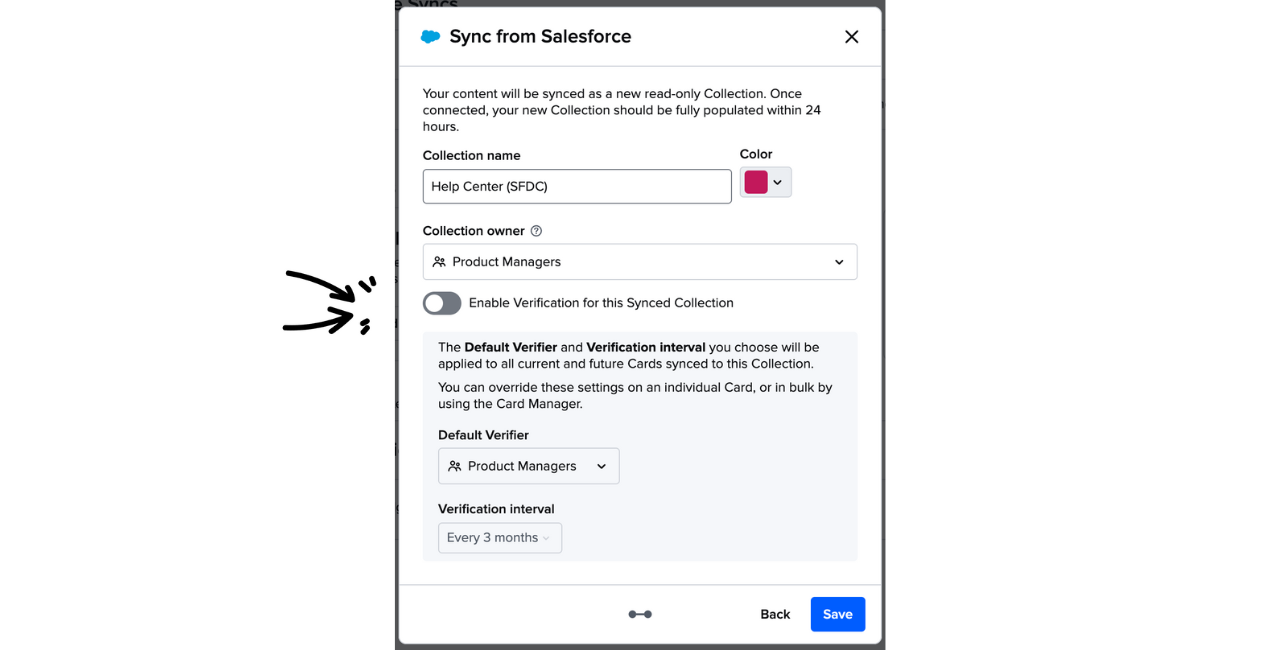Creating a Knowledge Sync: Zendesk Guide, Salesforce Knowledge, Confluence Pages
A Guru Knowledge Sync allows you to pull content from external sources into a read-only Collection in Guru. You can enable verification on synced content to show that the information is reviewed by subject matter experts. Synced Cards appear in search and when suggested answers are generated in the web app, browser extension, and Slack.
ImportantStarting in late June 2025, new Knowledge Sync connections are no longer supported. However, Workspaces that set up Knowledge Syncs before this change can continue to manage existing connections and create new ones.
Access RequiredOnly Guru Admins can set up a Knowledge Sync.
NoteA Knowledge Sync is different from a Source sync. Here are some key differences:
Knowledge Sync Source Sync Imports structured content into Guru as searchable Cards Connects external content to power AI-generated Answers without creating Cards. Can be used for AI-generated Answers, but content is also searchable within Guru itself. Only visible via AI-generated Answers Limited to Zendesk Guide Articles, Confluence Pages, and Salesforce Knowledge Articles. Supports a wide range of platforms For information on Sources, see: Connecting Sources to Guru for AI Answers.
Understanding sync compatibility
| Content Source | Internal Content Sync | External Content Sync | Notes |
|---|---|---|---|
| Zendesk Guide Articles | ✓ | ✓ | All published articles sync. Drafts will not sync. Visibility settings are ignored. |
| Confluence Pages | ✓ | Only supports Confluence Cloud. Guru will sync the entire Confluence Space. | |
| Salesforce Knowledge Articles | ✓ | Drafted or archived content will not sync. |
Setting up a Knowledge Sync
ImportantAs of late June 2025, new Knowledge Sync connections are no longer supported. Existing Knowledge Syncs will continue to function for teams that had them configured prior to this change, but no new syncs can be created going forward.
Credential requirements by sync source
Confluence
- Enter your Confluence sub-domain and space abbreviation (found in Space Settings > Key).
- Generate an API token, name it (e.g., "Guru Content Sync"), and copy it into Guru.
- Use the email address associated with the API token.
- If you're syncing from Confluence On-Premise, follow this guide and contact Guru support.
Salesforce
- Authorize using your Salesforce username and password.
- Once authorized, select your Locale from the dropdown menu.
Zendesk
- Enter your Zendesk Account Host (the
xxxxxpart ofxxxxx.zendesk.com/hc/en-us). - Click Authorize. Log in if prompted.
- Choose a Locale.
- Optional: To sync from a specific brand, use the Sync from a brand (advanced option) and enter your Brand subdomain.
Assigning a default verifier
When creating a Knowledge Sync, you can assign a Default Verifier to maintain content accuracy.

By default:
- Verification is enabled when a Collection owner Group is selected.
- The selected Group becomes the Verifier (you can override this on individual Cards or in bulk via Card Manager).
- The Verification Interval defaults to 3 months, but can be customized.
Frequently asked questions about Knowledge Syncs
How does a knowledge sync work?
- Syncs are unidirectional. Only public-facing content is imported.
- Private or draft content will not sync.
- Synced Collections must have a Collection owner Group with at least one member.
- Guru syncs changes regularly and removes content no longer present at the source.
- Synced Cards include the source URL and support verification, tags, and comments.
How often does knowledge sync run?
Guru syncs approximately every 6 hours. The last sync time is visible on the Collection and each Card.
How are synced Cards different from other Guru Cards?
- All Cards in synced Collections are read-only.
- Folders cannot be edited within Guru.
- Cards cannot be moved to another Collection.
- Cards cannot be archived or made public/restricted individually.
- Permissions are set at the Collection or Folder level.
- Cards can be verified if enabled.
View a Card’s Verification menu to see its origin and sync date.
What happens if the owner of a synced Collection is removed?
Guru automatically reassigns ownership in this order:
- Collection Owner
- First Card author (alphabetically)
- First Viewer (read-only)
If needed, create a new sync and delete the old one.
Can I transfer ownership of a synced Collection?
No. You must create a new sync with new credentials and delete the old Collection once verified.
How can I delete a synced Collection?
- Go to Manage > Collections > Knowledge Syncs.
- Click the trash icon next to the sync.
- The Collection and its Cards will be deleted immediately.
Is there a limit to the number of synced Cards?
Yes. Each sync supports up to 5,000 Cards.
How many levels of Salesforce Knowledge hierarchy does Guru support?
Salesforce supports 5 levels; Guru supports 3 folder levels. Guru rolls up the lowest 2 Salesforce levels.
Can I sync Salesforce sandbox Knowledge to Guru?
No. Syncing sandbox environments is not currently supported.
Want a closer look at some key Guru features and best practices?Check out our events page for demos, workshops, new release roundups, Getting Started bootcamp, guest panelists and more! For upcoming live events and a series of past recordings: Click here to register
Updated 3 months ago
